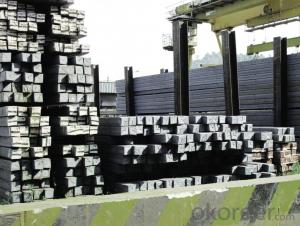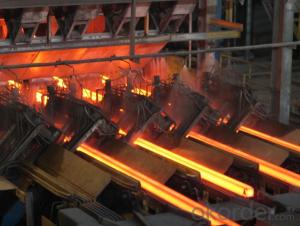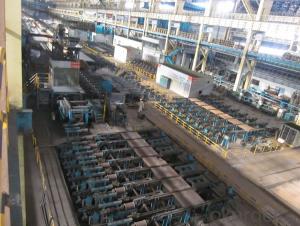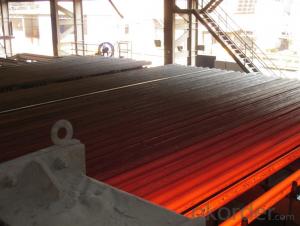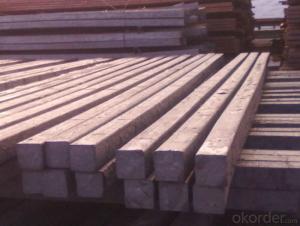Prime Q275 100mm Square Alloy Steel Billet
- Loading Port:
- Shanghai
- Payment Terms:
- TT OR LC
- Min Order Qty:
- 100 m.t.
- Supply Capability:
- 10000 m.t./month
OKorder Service Pledge
OKorder Financial Service
You Might Also Like
Structure of Prime Q275 100mm Square Alloy Steel Billet

Description of Prime Q275 100mm Square Alloy Steel Billet
1. Prepainted steel coil is coated with organic layer, which provides higher anti-corrosion property and a longer lifespan than that of galvanized or galvalume steel sheets.
2. The base metals for prepainted steel coil consist of cold rolled, HDGI Steel, electro-galvanized and hot-dip alu-zinc coated steel. The finish coats of prepainted steel coil can be classified into groups as follows: polyester, silicon modified polyesters, polyvinylidene fluoride, high-durability polyester, etc.
3. The production process has evolved from one-coating-and-one-baking to double-coating-and-double-baking, and even three-coating-and-three-baking.
4. The color of the prepainted steel coil has a very wide selection, like orange, cream-colored, dark sky blue, sea blue, bright red, brick red, ivory white, porcelain blue, etc.
5. The prepainted steel coils can also be classified into groups by their surface textures, namely regular prepainted sheets, embossed sheets and printed sheets.

Main Feature of Prime Q275 100mm Square Alloy Steel Billet
Uncoated CR steel sheet
With the features of in line with the international highest standards in demension and shape, excellent surface finish and properties, the products are mainly used in home appliance and automobile industries.
Galvanized steel sheet(include HDG and EG)
With the features of good corrosion resistance, the products are mainly used in automobile, home appliance, electronics, building and machinery manufacture industries, etc.
Precoated steel sheet
With the features of enviromental protection and good processablility, long lasting surface durability, rich in colors, the products are maily used in building, home appliance and furniture industries, etc.
Applications of Prime Q275 100mm Square Alloy Steel Billet
A. Corrugated design makes it excellent waterproof performance
B. Materials as prepainted steel sheets, galvanized steel sheets, galvalume (Al-Zn coated sheets) are available to make corrugated sheet.
C.Those material are durable, anti-corrosion in bad weather for 20-30 years based on it's Zinc(Galvanized) coating or AZ (Galvalume) coating.
D. Different shape of the sheet make it suitable for any style of buildings.
E.Easy to install, no need special tools to fix the sheet.
F.Light weight due to high strength to weight ratio of steel. Light weight means easier handling lower shipping costs, easier installation
G. Different color is availbe base on the RAL Standard make your building more beautiful.
H. We will provide the best solutions if you don't have a exact idea of the specification you want for the steel sheet based on your weather conditions, engineering structure, construction budget and so on.

Specifications of Prime Q275 100mm Square Alloy Steel Billet
Product | Billet |
Material Grade | SGCC / SGCH / DX51D+AZ, etc |
Thickness | 0.6-3.0mm |
Width | 500-1500mm |
Tolerance | Thickness: +/-0.02mm , Width:+/-2mm |
Zinc-coating | Z30-150g/m2 |
Technique | Raw material: Hot rolled steel coil --> Cold rolled_>hot dipped galvalume |
Surface | Dried, Chromated, Unoiled |
Spangle | Regular spangle , small spangle, zero spangle |
ID | 508MM 610MM |
Coil weight | 1-25MT |
Export package | Cardboard inner sleeves, Waterproof paper, galvanized steel covered and steel strip packed |
FAQ of Prime Q275 100mm Square Alloy Steel Billet
We have organized several common questions for our clients,may help you sincerely:
1. How Can I Visit There?
Our company is located in Tianjin City, China, near Beijing. You can fly to Tianjin Airport Directly. All our clients, from home or aboard, are warmly welcome to visit us!
2. How Can I Get Some Sample?
We are honored to offer you sample.
3. Why choose CNBM?
Our delivery time about 15-20days for standard sizes, if you have other requirements like hardness, quanity and width ,it is about 20-40days. But don't worry we also try our best for the delivery time ,because time longer and our cost is higher.
- Q:What are the different surface finishing techniques used for steel billets?
- There are several surface finishing techniques that are commonly used for steel billets. These techniques are employed to enhance the appearance, improve corrosion resistance, and provide a protective coating to the steel billets. Some of the different surface finishing techniques used for steel billets are: 1. Hot Rolling: This technique involves passing the steel billets through a series of hot rollers, which not only shapes the billets but also creates a smooth surface finish. Hot rolling is commonly used to produce steel plates, sheets, or structural shapes. 2. Cold Rolling: Cold rolling is similar to hot rolling, but it is performed at room temperature. This technique helps to achieve a smoother surface finish, increased dimensional accuracy, and improved mechanical properties of the steel billets. 3. Shot Blasting: Shot blasting is a process where steel billets are bombarded with small metallic or non-metallic particles at high velocity. This technique helps to remove scale, rust, and other contaminants from the billet's surface, resulting in a clean and uniform appearance. 4. Pickling: Pickling involves immersing the steel billets in an acid solution to remove oxides, scale, and rust from the surface. This technique helps to achieve a clean and smooth surface finish, ready for further processing or coating. 5. Galvanizing: Galvanizing is a popular surface finishing technique that involves coating the steel billets with a layer of zinc. This coating provides excellent corrosion resistance and protects the steel from environmental factors. Galvanizing can be done through hot-dip galvanizing, electro-galvanizing, or mechanical galvanizing methods. 6. Painting: Painting is often used as a surface finishing technique for steel billets. It involves applying a layer of paint or protective coating to the surface, which not only enhances the appearance but also provides protection against corrosion and weathering. 7. Passivation: Passivation is a chemical process used to remove free iron or iron oxides from the surface of steel billets. This process helps to improve the corrosion resistance of the steel and leaves a clean and passive surface. 8. Polishing: Polishing involves using abrasive materials or compounds to smoothen the surface of the steel billets. This technique is commonly used to achieve a high gloss or mirror-like finish, enhancing the aesthetic appeal of the steel. Each of these surface finishing techniques offers its own advantages and is chosen based on the specific requirements of the steel billets, such as appearance, corrosion resistance, and functionality.
- Q:What are the potential applications of steel billets in the food and beverage sector?
- Due to their unique properties, steel billets offer a wide range of potential applications in the food and beverage sector. One possible use is for constructing food processing equipment. Steel billets can be transformed into mixers, blenders, and conveyors, which are vital in the food processing industry. The exceptional strength and durability of steel make it an ideal material for withstanding the demanding conditions of food production. Another potential application is in the manufacturing of storage containers and tanks for food and beverage preservation. Steel billets can be converted into corrosion-resistant containers that are safe for storing liquids and food products. These containers are commonly utilized in breweries, wineries, and other beverage production facilities for storing ingredients, fermenting products, and finished goods. Additionally, steel billets can be employed in the construction of food transportation systems. Trucks and trailers that transport perishable goods often require sturdy and durable frames to ensure the products' safety and integrity. Steel billets can be utilized to manufacture these frames, providing a reliable and secure means of transportation for food and beverage products. Moreover, steel billets can be utilized in the construction of food service equipment, such as commercial ovens, grills, and fryers. These appliances necessitate materials that can withstand high temperatures and maintain their structural integrity over extended periods of use. Steel billets, with their exceptional heat resistance and strength, can fulfill these requirements, making them suitable for the foodservice industry. In conclusion, the potential applications of steel billets in the food and beverage sector are extensive. Whether it is for food processing equipment, storage containers, transportation systems, or food service equipment, steel billets provide the necessary strength, durability, and corrosion resistance to ensure the safety and efficiency of food production and distribution processes.
- Q:How are steel billets used in the manufacturing of marine components?
- Due to their strength, durability, and versatility, steel billets are indispensable raw materials utilized in the production of marine components. Essentially, steel billets are semi-finished steel products that are cast into specific shapes, typically squares or rectangles, via continuous casting. These billets serve as the initial stage for a variety of marine components. Hot rolling is a primary method employed in the manufacturing of marine components using steel billets. In this process, the steel billet is heated to high temperatures and then passed through a series of rollers to shape it into the desired form. This can involve transforming the billet into rods, bars, beams, or other structural shapes commonly utilized in marine applications. Forging is another technique employed in the manufacturing of marine components using steel billets. This process involves heating the billet to high temperatures and subsequently applying pressure to shape it into the desired form. Forging is commonly employed to manufacture marine components such as propeller shafts, crankshafts, and other high-strength parts that necessitate precise shaping and exceptional mechanical properties. Furthermore, steel billets can be utilized in the manufacturing of marine components through the process of machining. Machining entails the removal of material from the billet using various cutting tools to create intricate shapes and features. This method is commonly employed to produce marine components such as valves, fittings, and other precision parts that require meticulous tolerances and intricate designs. In conclusion, steel billets play a pivotal role in the manufacturing of marine components. Their strength, durability, and versatility make them an ideal raw material for producing various marine parts through processes such as hot rolling, forging, and machining. By utilizing steel billets, manufacturers can ensure that the marine components they produce are capable of withstanding the harsh conditions and demanding requirements of the marine environment.
- Q:How are steel billets used in the production of gears?
- Steel billets are used in the production of gears as the raw material from which the gears are manufactured. Billets are essentially semi-finished steel products that have a square or rectangular cross-section. They are heated and then hot-rolled into shape to form the desired gear. The first step in using steel billets for gear production is to select the appropriate grade of steel. The steel should have specific mechanical properties, such as high strength, toughness, and wear resistance, to ensure the gears can withstand the demanding conditions they will be subjected to during operation. Once the steel billets are selected, they are heated to a high temperature to make them malleable and easier to shape. This process, known as hot working, allows the steel to be deformed without cracking or fracturing. The billets are then passed through a series of rollers to form the desired shape and dimensions of the gear. After the initial shaping process, the gears may undergo further machining operations to refine their shape and improve their precision. This may include processes such as milling, grinding, or hobbing to remove excess material and create the final gear profile. These machining operations ensure that the gears meet the required tolerances and have smooth surfaces for optimal performance. Once the gears are machined to the desired specifications, they may undergo heat treatment processes such as quenching and tempering to enhance their mechanical properties. This helps to increase the hardness and strength of the gears, making them more durable and resistant to wear. Overall, steel billets play a crucial role in the production of gears as they serve as the starting material for the manufacturing process. Through heating, shaping, machining, and heat treatment processes, steel billets are transformed into high-quality gears that are strong, durable, and precisely engineered to meet the specific requirements of various mechanical applications.
- Q:Can steel billets be used for artistic purposes?
- Absolutely, steel billets have the potential to be utilized for artistic purposes. Although steel billets are typically employed as raw materials for industrial applications such as construction or manufacturing, they can also be artfully transformed into exquisite pieces. Sculptures, decorative items, and even functional objects like furniture can all be crafted from steel billets by artists. The malleability of steel allows artists to shape and mold it into various forms, and its robustness and longevity ensure that the artwork will endure. Additionally, the metallic appearance of steel can infuse artistic creations with a contemporary and industrial aesthetic. All in all, steel billets offer artists a distinctive medium to unleash their creativity and produce visually stunning works.
- Q:How are steel billets used in the manufacturing of construction scaffolding?
- The manufacturing of construction scaffolding relies heavily on steel billets, which are an indispensable raw material. Initially, the billets are heated and then passed through rolling mills to achieve the desired shape and size for scaffolding components. Once the steel billets have been rolled to the required shape, they undergo further processing to create different scaffolding parts such as tubes, couplers, frames, and planks. These parts are then assembled together to form the scaffolding structure, which provides a secure and stable platform for workers during construction projects at elevated heights. There are several advantages to using steel billets in the manufacturing of construction scaffolding. Firstly, steel is renowned for its exceptional strength and durability, making it an ideal material for scaffolding. Additionally, it is resistant to corrosion and capable of withstanding harsh weather conditions, ensuring the scaffolding remains reliable and safe throughout the construction process. Furthermore, steel scaffolding is highly versatile and can be easily customized to meet various project requirements. By using steel billets, manufacturers can create scaffolding components of different sizes, shapes, and configurations to accommodate diverse construction needs. In conclusion, steel billets play a crucial role in the manufacturing of construction scaffolding. By utilizing these raw materials, scaffolding manufacturers can produce scaffolding structures that are durable, reliable, and customizable, ultimately enhancing safety and efficiency on construction sites.
- Q:Can steel billets be used for making cutlery?
- Yes, steel billets can be used for making cutlery. Steel billets are the raw material used in the production of various steel products, including cutlery. The billets are heated and then shaped into desired forms, such as knives, forks, or spoons, through processes like forging or casting. The resulting steel cutlery is known for its strength, durability, and ability to hold a sharp edge. However, it is important to note that the specific type of steel used and the manufacturing processes play a significant role in determining the quality and characteristics of the cutlery.
- Q:How are steel billets stored to prevent corrosion?
- Steel billets are typically stored in covered warehouses or under protective tarps to shield them from moisture and exposure to air. Additionally, a corrosion inhibitor such as a rust-preventive coating or oil may be applied to the surface of the billets to create a barrier against oxidation.
- Q:How are steel billets used in the manufacturing of forgings?
- Steel billets are an essential raw material in the manufacturing of forgings. These billets, which are semi-finished steel products, are used as the starting point for shaping and forming various types of forgings. The process begins with the selection of appropriate steel billets based on their chemical composition and mechanical properties. The billets are typically made from high-quality carbon or alloy steel and are carefully inspected to ensure their suitability for the desired end product. Once the billets are selected, they undergo a series of heating and shaping operations. The billets are heated to a specific temperature, known as the forging temperature, in a furnace to make them more malleable. This temperature is carefully controlled to ensure optimal plasticity and minimize any potential defects. After reaching the forging temperature, the billets are transferred to a forging press or hammer. These powerful machines apply immense pressure to shape the billet into the desired form. The force exerted by the press or hammer causes the billet to deform and take on the shape of the die or mold being used. The forged billet may undergo several additional steps, such as trimming, piercing, or machining, to achieve the final desired shape. These steps are necessary to remove any excess material or refine the forged part further. Throughout the manufacturing process, the quality of the steel billets plays a crucial role in determining the final quality of the forgings. The billets must have consistent chemical composition, mechanical properties, and freedom from defects. This ensures that the forged parts have the desired strength, durability, and dimensional accuracy. In summary, steel billets are used in the manufacturing of forgings as the initial material that undergoes heating, shaping, and other processes to create the final forged part. The quality of the billets directly impacts the quality of the forgings, making the selection and inspection of billets a critical step in the overall manufacturing process.
- Q:What is the difference between carbon three plants and carbon four plants?
- The mesophyll cells of carbon three plants are more dispersed, and there are no chloroplasts in bundle sheath cells. Photosynthesis is only carbon three cycle, and the utilization rate of carbon dioxide is low. It usually lives in temperate zone.Four carbon plant mesophyll cells arranged regularly, the formation of two circles of the "ring" and bundle sheath cells, bundle sheath cells have no chloroplast grana, photosynthesis has three carbon cycle and carbon cycle four, higher utilization rate of carbon dioxide, the general life in tropical and subtropical regions.The initial product of CO2 assimilation is not photosynthetic carbon cycle in three carbon compounds 3- phosphoglycerate, but four carbon compounds malic acid or aspartic acid plant.
1. Manufacturer Overview |
|
|---|---|
| Location | |
| Year Established | |
| Annual Output Value | |
| Main Markets | |
| Company Certifications | |
2. Manufacturer Certificates |
|
|---|---|
| a) Certification Name | |
| Range | |
| Reference | |
| Validity Period | |
3. Manufacturer Capability |
|
|---|---|
| a)Trade Capacity | |
| Nearest Port | |
| Export Percentage | |
| No.of Employees in Trade Department | |
| Language Spoken: | |
| b)Factory Information | |
| Factory Size: | |
| No. of Production Lines | |
| Contract Manufacturing | |
| Product Price Range | |
Send your message to us
Prime Q275 100mm Square Alloy Steel Billet
- Loading Port:
- Shanghai
- Payment Terms:
- TT OR LC
- Min Order Qty:
- 100 m.t.
- Supply Capability:
- 10000 m.t./month
OKorder Service Pledge
OKorder Financial Service
Similar products
New products
Hot products
Hot Searches
Related keywords
